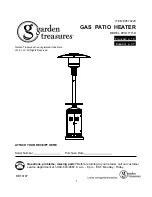
22 • Residential Gas Water Heater Use and Care Guide
Step: 8
Verify Connections and
Completely Fill Tank
To remove air from the tank and allow
the tank to fill completely with water,
follow these steps:
1
Remove the flow restrictor at
the nearest hot water faucet.
This allows debris in the
plumbing system to be washed out of
the pipes.
2
Turn the cold water supply
back on and fill the tank.
Figure 43 -
Fully open the cold water supply
valve.
3
Open a hot water faucet and
allow the water to run until it
flows with a full stream.
4
Let the water run full stream
for three minutes.
5
Close the hot water faucet
and replace the flow
restrictor.
6
Check the inlet and outlet
connections and water pipes
for leaks. Dry pipe
connections so that any drips or leaks
will be apparent. Repair any leaks.
Almost all leaks occur at connections
and are not a tank leak.
Step: 9
Install Vent Pipe
1
Install the new vent pipe on
top of the water heater. Do
not reuse the vent pipe from
the old water heater, but rather use
the new one that came with your new
water heater. Follow “Venting” on
page 8.
Step: 10
Make Gas Connections
The Gas Water Heater Hook-Up Kit
(available at your local plumbing
supplier) includes a flexible gas
connector with compression fittings
to connect the home’s gas line
to the water heater’s gas control
valve. Follow the kit’s installation
instructions to attach the flexible gas
connector.
Figure 44 -
Flexible Gas Line Connector
Once you have made the gas
connections, use a small, soft-bristled
brush to apply a hand dishwashing
soap and water mixture or children’s
soap bubbles (1 part soap to 15 parts
water) to all connection points of the
gas line and flexible gas connector (if
used). Make sure to generously coat
all the connections and check for
gas leaks (which will appear as small
bubbles). If any leaks are detected,
turn the gas supply off, tighten the
leaking connections and re-check.
INS
TALLA
TION
INSTALLATION















































